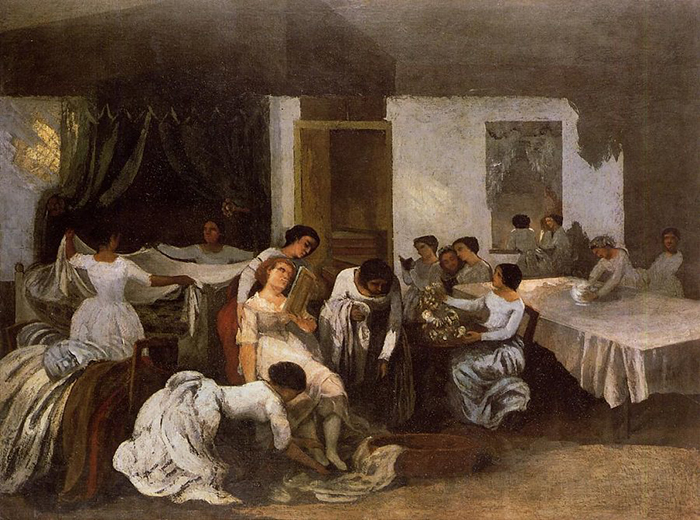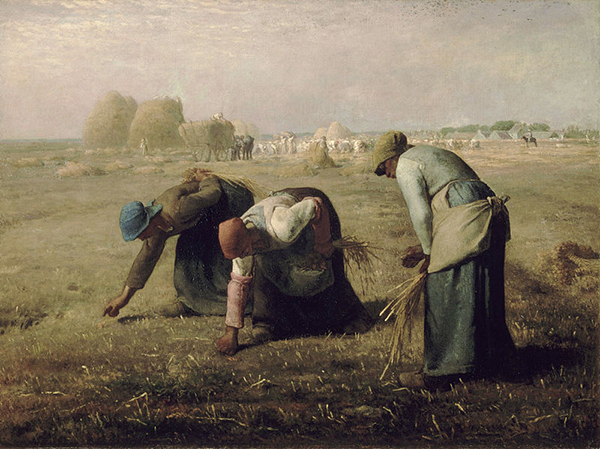Reaction Against Realism
F.W.J. Hemmings, Culture and Society in France, 1848-1898: Dissidents and Philistines (New York: Charles Schribner’s Sons, 1971), pp.79-81
Jean-François Millet, The Gleaners (1857) |
The very real anger and disgust aroused by the realists during the decade in which they first came to public notice was more seriously motivated, however, than Banville's trivial sarcasms might suggest. Their doctrine, and much more blatantly the first-fruits of this doctrine which were the canvases of Courbet, called sharply into question the age-old belief that the whole mission of art was to give visible form to beauty, however the concept of beauty might be interpreted, and that an understanding of beauty, whether intuitively attained or laboriously acquired through education, was what determined the acquisition of taste. This faith, the roots of which reach back to the High Renaissance and beyond that, no doubt, to Plotinus and the neo Platonists, had of course undergone certain important modifications in the course of time, but the central dogma had never before been assailed. The leading theoreticians of the eighteenth century had rejected the concept of an aesthetic absolute in favour of a system of relative variables; as Voltaire put it, a toad would imagine Venus in the form of a female toad, but this did not mean that the toad was lacking in aesthetic sense. Later, Mme de Stael suggested that race, climate, latitude, customs, religion, and national history, all these might influence what people regarded as constituting the beautiful in art. But neither the Abbe Du Bos, who was the first writer in France to challenge the notion of absolute beauty, nor Voltaire nor Mme de Stael doubted for one moment that the aim of art was to create or distil the beauty that was present in nature only in a dormant or inchoate state.
Nor was this belief seriously impaired by the Romantic revolution that Mme de Stael helped to promote. Whatever arguments Hugo may have used in the preface to Cromwell and elsewhere, to justify adding the grotesque and the sinister to the catalogue of aesthetically valuable elements, neither the Romantics themselves nor post-Romantics like Gautier seriously believed that crude, unadorned, unprocessed reality could be incorporated just as it was into the work of art. The typical reaction to such a suggestion -- still falteringly and obliquely advanced, at the time -- is to be found in Vigny's essay, 'Reflexions sur la verite dans l'art' [“Reflections on Truth in Art”], which was printed as a preface to the fourth edition (1829) of his historical novel Cinq-Mars. 'What value have the arts', wrote Vigny, 'if they are no more than the reduplication and repetition of existence? Ah! good God, we see enough of it all around us, that gloomy, disenchanting reality.' In the 1840's, notwithstanding the example given by the landscape painters of the Barbizon school, the idea that beauty might emerge from straightforward representation of the model still faced immense resistance. . . .
Apart from the aesthetic counter-arguments, there were other reasons for ' the widespread hostility to realism which are traceable to its iconoclastic ideology. Academic art, to which realism was opposed and which it hoped to supersede, was linked through the long-standing system of public patron age, official rewards and honours, and state-supported teaching centres, to the established order. That the status of the fashionable and popular products of the Ecole des Beaux-Arts was endangered by the emergence of new methods and new preoccupations which seemed to have little in common with the great traditions of the past, would not in itself have mattered so much if the central government had not developed a vested interest in the maintenance of the artistic status quo. Partly because the Second Empire laid such store by outward display and attached such importance to the acknowledged supremacy of French art throughout the world, a movement which seemed to threaten this supremacy from within by challenging its dearest assumptions was easily construed as a danger to national pride and prestige. At least one attempt was made, as we shall see, to persuade Courbet to modify his intransigence in return for official support and approval. On another occasion a minister of the Crown (Fould) took it on himself to use the full weight of the authority that his position gave him in order to denounce the realists and all their works.
There was another sense in which realism could be regarded as the opposition art par excellence under the Second Empire. Deliberately and, it would seem, provocatively, it sought its inspiration and its subjects among the less privileged classes of society which academic art had tended to ignore -- though, all through the seventeenth and eighteenth centuries there had been painters (Le Nain, Chardin, Greuze) and novelists (Sorel, Marivaux, Restif de La Bretonne) who had found their models in the fields and farmyards, in the back rooms of small shops or the servants' hall, and discovered in these lowly settings the scenes they wished to paint and record. In literature, this tradition had persisted thanks to Balzac, Eugene Sue, George Sand and other novelists oflesser calibre. In art it had fallen into abeyance and into corruption until, as we shall see, first Millet, then Courbet revived it.

Dressing the Dead Girl, 1850's by Gustave Courbet
